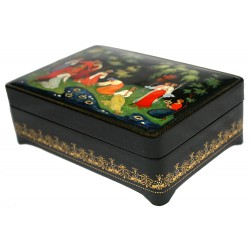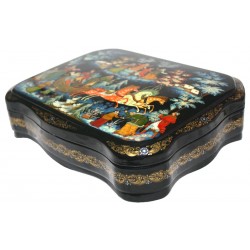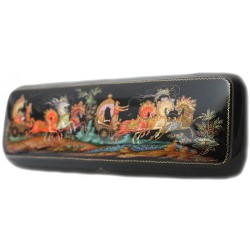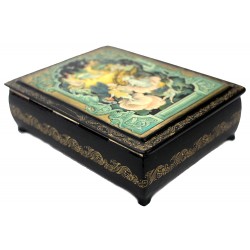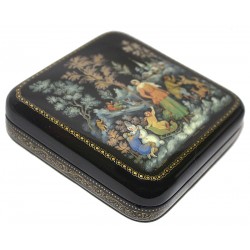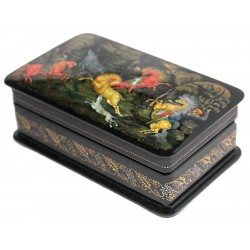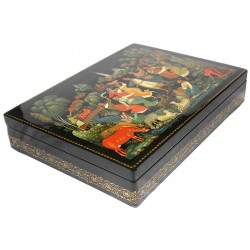No products
Product successfully added to your shopping cart
There are 0 items in your cart. There is 1 item in your cart.
PALEKH
Catalog
New products
-

The Bronze Horseman(Monument to Peter the Great in St.Petersburg), 1965
Arist: Karapaev Yuriy(1936-2009); Size: 9x13.5x5
$425.00 -

The Bronze Horseman(Monument to Peter the Great in St.Petersburg)
Arist: Gordeev V.; Size: 9.5x6.5
$375.00 -

-

-

-

A little town of Palekh is located in 360 kilometers to the east from Moscow.This is about 60 kilometeres from town of Ivanovo, to which region Palekh belongs.
Palekh was previously a center of icon painting and as such it is mentioned several times in the documents of the 17th century.Icon painting was a family occupation and the craft was passed on from one generation to another.
The Revolution of October 1917 dealt a heavy blow to icon painting in Palekh and throughout Russia. Not only the holy images themselves but the artists who made them became enemies to Communist regime and were persecuted or arrested. As icon and mural paintings were no longer in demand many masters returned to agriculture others tried to go to other handicrafts such as shoemaking, carrier's trading, wickering bast shoes, making toys and dish. Some Palekh masters went to different towns looking for job.
In 1918 the former icon-painters established the First Palekh Co-operative of Decorative Art but it soon fell apart.
In 1922 Ivan I. Golikov being in Moscow saw a black papier-mache box from Fedoskino in the Handicraft Museum.
He painted a papier-mache piece using techniques of icon-painting and technology of the Lukutin lacquer work and had a success.
In 1923 Palekh masters won the first price at the All-Union Exhibition of Agriculture and Industry in Moscow.
Succesful exhibitions of their first works in Moscow and Venice inspired the artists, and on the 5th of December 1924 seven Palekh masters I.I.Golikov, I.M.Bakanov, A.I.Zubkov, I.I.Zubkov, A.V.Kotukhin, V.V.Kotukhin and I.V.Markichev organized an Artel of Ancient Painting.
The new times demanded new themes and subjects. Indeed their paintings abound in peasantry and revolutionary themes, such as reflecting the heroism of the people, reaping, hay making fishing, hunting, circle-dancing, merrymaking, horse-riding. From the very beginning Palekh painters made generous use of folk motives and poetry of Pushkin, Lermontov, Gorky and others.
The most difficult task for Palekh artists was to draw on a thing having form and volume. The range of articles was very wide: brooches, jars, small boxes, bead-boxes, cigarette-cases, snuff-boxes, powder-boxes, panels, glove boxes and so on.
For the transfering the experience of Old masters to young gifted people in 1933 was opened Palekh Art School.
On the 10th anniversary of the Artel on March 1935 came several hundreds of delegates. The Great meeting was opened by a Minister of Education of the Russian Federation. The State Museum of Palekh Arts was opened by the date. The Artel was renamed into Association of Palekh Artists.
Stalin's repressions of 1930-40s and tragedy of Great Patriotic War(World War II) did not pass Palekh artists,they lost some of their talents.
In the 1950s,when many of the first generation had passed away,the development of geniune Palekh was threatened by a learning towards realism which impoverished the poetic language of the painting and could have led to a consequent loss of many stylistic features inherited from Paalekh icon-painting.The changes that soon after that began in Soviet society helped Palekh to stand firm.Palekh College graduates of the late 60s and early 70s started a revival by turning back to the sources of Palekh.This generation has in many respects outlined the main features of today's Palekh and is paving the way for it's future development.The influx of gifted young people promises further development and prosperity in Palekh Art.
In the 1960s many talented painters arrived at Palekh and among them there were Boris Yermolayev, Nikolay Golikov, Alexey Kochupalov, Anatoliy Peskov, Valentin and Tatiana Khodovs, Alexander Klipov, Stanislav Butorin, Gennadiy Kochetov, Irina Livanova, Nina Bogachyova. In the 1970s Vladimir and Natalie Buldakovs, Nikolay Gribov, Yuriy and Yekaterina Schanitsyns, Vadim Zotov, Anna Kamanina, Nikolay Lopatin, Lubov Nekrasova, Olga Subbotina joined them. All of them took the traditions of Palekh seriously and started working them out imaginatively. The 1980s can be called the period of the renaissance of Palekh Art with their names.
Nowadays there are several different co-operatives and Workshops successfuly working in Palekh.
Based on Vadim Shchanitsyn's Book-"Palekh and Palekhians"1994, published by Zet Industrial Co.
PALEKH There are 375 products.
Winter outdoor fun
This very detailed box has been painted by a talented Palekh artist Natalie Lukina. It shows happy Russian peasants enjoying a frosty, winter day.
$490.00In StockWinter Troyka
Talented artist Arapova Anastasia from the village of Palekh has painted this scene with a winter troika (three horse sleigh) speeding through the Russian countryside. A loving couple hide from the snowstorm in the sleigh while a driver encourages the horses.
$525.00In StockTale of Ivan Tsarevich and a Gray Wolf
This five-sided casket is a creation of talented Palekh artist Belousova Galina whose favorite themes to depict are folklore and genre scenes. Casket shows several episodes from tale of Ivan Tsarevich and a Gray Wolf.
$650.00In StockSnowmaiden
This splendid box was painted by the talented Palekh artist Arapova Anastasa. It shows a scene from the popular Russian fairy-tale "The Snowmaiden" or "Snegurochka". The composition is showing the date of Lel and Snowmaiden. Lel is playing his flute to Snowmaiden while the Snowmaiden is speaking with birds.
John the Baptist Day
Talented artist Arapova Anastasia of Palekh painted this wonderfully creative scene. It shows how the Russians celebrate an ancient pagan feast, which is called the Ivan Kupala Day.
$650.00In StockWinter amusement
This interesting Palekh composition has been painted by Nina Suloeva. It shows all kinds of winter outdoor fun in countryside.
$895.00In StockSnowmaiden
This dual-sided box was painted by the talented Palekh artist Ludmila Gelisheva. It shows the scenes from the popular Russian fairy-tale "The Snowmaiden".The tale was also adapted into an opera by Nikolai Rimsky-Korsakov.
$650.00 $795.00In StockFestive Troykas
Well-known Palekh Master and a teacher of Palekh Art school Vladimir Vlezko is the artist who painted this scene. Here we see two troykas racing through a field of summer flowers at a blistering pace while a driver encourages the horses.
$399.00 $475.00In StockThumbelina
This attractive box has been painted by Alexey Skalozub. Alexey has been stydied in the Palekh Art School in 1991-1996.
$425.00 $480.00In StockWinter Day
This detailed box has been painted by Tatiana Kamanina from the village of Palekh. It features traditional Russian winter amusements. Some of the kids making snowman , skate, sleigh, ski or just playing with dogs.
$450.00 $550.00In StockHunt after the Deer
Talented artist Kruykova Valentina from the village of Palekh has painted this scene with a deer hunt.Gold paint is used to detail the hunters' costumes and the horses' and deers' harnesses.
$250.00 $295.00In StockSunrise
This interesting and very detailed plate has been painted by a talented Palekh artist, Marie Bakareva.The work is called Sunrise.The plate is made of paper-mache. The work is signed with the artist name,title, Palekh and the year of 2015.
$1,950.00In StockRed Army Soldier
$7,500.00Letter from Red Army
$3,600.00Snowmaiden
This pencil-box shaped box was painted by the talented Palekh artist Ludmila Gelisheva. It shows some scenes from the popular Russian fairy-tale "The Snowmaiden".
$350.00 $450.00In Stock







